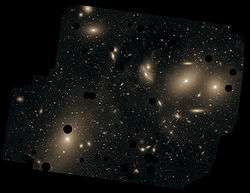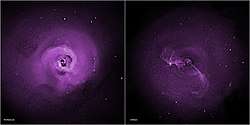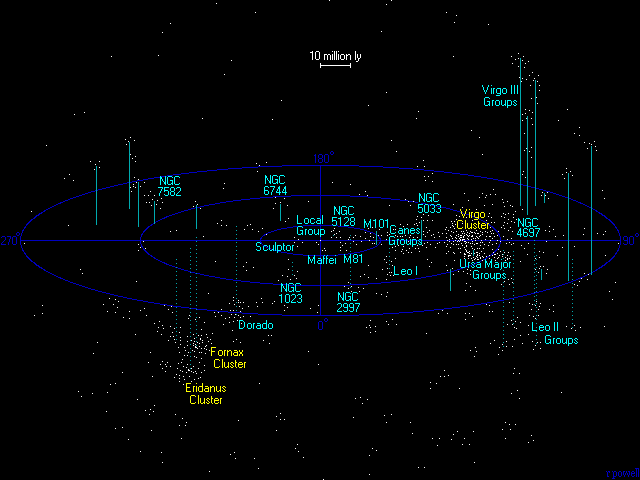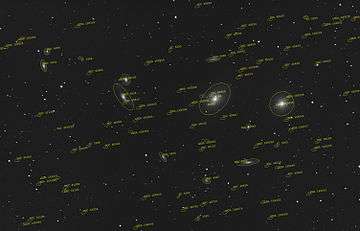Virgo Cluster
The Virgo Cluster is a cluster of galaxies whose center is 53.8 ± 0.3 Mly (16.5 ± 0.1 Mpc)[2] away in the constellation Virgo. Comprising approximately 1300 (and possibly up to 2000) member galaxies,[3] the cluster forms the heart of the larger Virgo Supercluster, of which the Local Group (containing our Milky Way galaxy) is a member. The Local Group actually experiences the mass of the Virgo Supercluster as the Virgocentric flow. It is estimated that the Virgo Cluster's mass is 1.2×1015 M☉ out to 8 degrees of the cluster's center or a radius of about 2.2 Mpc.[4]
| Virgo Cluster | |
|---|---|
 Virgo Cluster showing the diffuse light between member galaxies. Messier 87 is the largest galaxy (lower left). | |
| Observation data (Epoch J2000) | |
| Constellation(s) | Virgo & Coma Berenices |
| Right ascension | 12h 27m[1] |
| Declination | +12° 43′[1] |
| Brightest member | Messier 49 |
| Number of galaxies | ~1500[1] |
| Bautz–Morgan classification | III[1] |
| Binding mass | 1015 M☉ |
Many of the brighter galaxies in this cluster, including the giant elliptical galaxy Messier 87, were discovered in the late 1770s and early 1780s and subsequently included in Charles Messier's catalogue of non-cometary fuzzy objects. Described by Messier as nebulae without stars, their true nature was not recognized until the 1920s.[upper-alpha 1]
The cluster subtends a maximum arc of approximately 8 degrees centered in the constellation Virgo. Although some of the cluster's most prominent members can be seen with smaller instruments, a 6-inch telescope will reveal about 160 of the cluster's galaxies on a clear night. Its brightest member is the elliptical galaxy Messier 49; however its most famous member is the elliptical galaxy Messier 87, which is located in the center of the cluster.[6]
Characteristics
The cluster is a fairly heterogeneous mixture of spirals and ellipticals.[7] As of 2004, it is believed that the spiral galaxies of the cluster are distributed in an oblong prolate filament, approximately four times as long as it is wide, stretching along the line of sight from the Milky Way.[8] The elliptical galaxies are more centrally concentrated than the spiral galaxies.[9]
The cluster is an aggregate of at least three separate subclumps: Virgo A, centered on M87, a second centered on the galaxy M86, and Virgo B, centered on M49, with some authors including a Virgo C subcluster, centered on the galaxy M60 as well as a LVC (Low Velocity Cloud) subclump, centered on the large spiral galaxy NGC 4216.[10]
Of all of the subclumps, Virgo A, formed by a mixture of elliptical, lenticular, and (usually) gas-poor spiral galaxies,[11] is the dominant one, with a mass of approximately 1014 M☉, which is approximately an order of magnitude larger than the other two subclumps.[12]

The three subgroups are in the process of merging to form a larger single cluster[12] and are surrounded by other smaller galaxy clouds, mostly composed of spiral galaxies, known as N Cloud, S Cloud, and Virgo E that are in the process of infalling to merge with them,[13] plus other farther isolated galaxies and galaxy groups (like the galaxy cloud Coma I) that are also attracted by the gravity of Virgo to merge with it in the future.[14] This strongly suggests the Virgo cluster is a dynamically young cluster that is still forming.[13]
Other two nearby aggregations known as M Cloud, W Cloud, and W' Cloud[10] seem to be background systems independent of the main cluster.[13]
The large mass of the cluster is indicated by the high peculiar velocities of many of its galaxies, sometimes as high as 1,600 km/s with respect to the cluster's center.
The Virgo cluster lies within the Virgo Supercluster, and its gravitational effect slows down the nearby galaxies. The large mass of the cluster has the effect of slowing down the recession of the Local Group from the cluster by approximately ten percent.
Intracluster medium
As with many other rich galaxy clusters, Virgo's intracluster medium is filled with a hot, rarefied plasma at temperatures of 30 million kelvins that emits X-Rays.[15] Within the intracluster medium (ICM) are found a large number of intergalactic stars[16][17] (up to 10% of the stars in the cluster),[18] including some planetary nebulae.[19] It is theorized that these were expelled from their home galaxies by interactions with other galaxies.[18] The ICM also contains some globular clusters,[20][21][22] possibly stripped off dwarf galaxies,[22] and even at least one star formation region.[23]
Galaxies


Below is given a table of bright or notable objects in the Virgo Cluster and the subunit of the cluster in which they are located. Note that in some cases a galaxy may be considered in a different subunit by other researchers (sources:[10][13][24][25])
- Column 1: The name of the galaxy.
- Column 2: The right ascension for epoch 2000.
- Column 3: The declination for epoch 2000.
- Column 4: The blue apparent magnitude of the galaxy.
- Column 5: The galaxy type: E=Elliptical, S0=Lenticular, Sa,Sb,Sc,Sd=Spiral, SBa,SBb,SBc,SBd=Barred spiral, Sm,SBm,Irr=Irregular.
- Column 6: The angular diameter of the galaxy (arcminutes).
- Column 7: The diameter of the galaxy (thousands of light years).
- Column 8: The recessional velocity (km/s) of the galaxy relative to the cosmic microwave background.
- Column 9: Subcluster where the galaxy is located.
| Designation | Coordinates (Epoch 2000) | Apparent magnitude (blue) |
Type | Angular size | Diameter (kly) |
RV (km/s) |
Subcluster | |
|---|---|---|---|---|---|---|---|---|
| RA | Dec | |||||||
| Messier 98 | 12 13.8 | 14 54 | 10.9 | SBb | 9.8′ | 150 | 184 | Virgo A or N Cloud |
| NGC 4216 | 12 15.9 | 13 09 | 10.9 | SBb | 7.9′ | 120 | 459 | Virgo A, N Cloud, or LVC. |
| Messier 99 | 12 18.8 | 14 25 | 10.4 | Sc | 5.4′ | 80 | 2735 | Virgo A or N Cloud |
| NGC 4262 | 12 19.5 | 14 53 | 12.4 | S0 | 1.9′ | 30 | 1683 | Virgo A |
| NGC 4388 | 12 25.5 | 12 39 | 11.8 | SAb | 6.2′ | 85 | 2845 | Virgo A |
| Messier 61 | 12 21.9 | 04 28 | 10.2 | SBbc | 6.2′ | 100 | 1911 | S Cloud |
| Messier 100 | 12 22.9 | 15 49 | 10.1 | SBbc | 7.6′ | 115 | 1899 | Virgo A |
| Messier 84 | 12 25.1 | 12 53 | 10.1 | E1 | 6.0′ | 90 | 1239 | Virgo A Markarian's Chain |
| Messier 85 | 12 25.4 | 18 11 | 10.0 | S0 | 7.1′ | 105 | 1056 | Virgo A |
| Messier 86 | 12 26.2 | 12 57 | 9.9 | E3 | 10.2′ | 155 | 37 | Virgo A or own subgroup. Markarian's Chain |
| NGC 4435 | 12 27.7 | 13 05 | 11.7 | S0 | 3.0′ | 45 | 1111 | Virgo A |
| NGC 4438 | 12 27.8 | 13 01 | 11.0 | Sa | 8.7′ | 130 | 404 | Virgo A |
| NGC 4450 | 12 28.5 | 17 05 | 10.9 | Sab | 5.1′ | 80 | 2273 | Virgo A |
| Messier 49 | 12 29.8 | 08 00 | 9.3 | E2 | 9.8′ | 150 | 1204 | Virgo B |
| Messier 87 | 12 30.8 | 12 23 | 9.6 | E0–1 | 9.8′ | 150 | 1204 | Virgo A |
| Messier 88 | 12 32.0 | 14 25 | 10.3 | Sb | 6.8′ | 100 | 2599 | Virgo A |
| NGC 4526 | 12 32.0 | 07 42 | 10.6 | S0 | 7.1′ | 105 | 931 | Virgo B |
| NGC 4527 | 12 34.1 | 02 39 | 12.4 | Sb | 4.6′ | 69 | 1730 | S Cloud |
| NGC 4536 | 12 34.4 | 02 11 | 11.1 | SBbc | 7.2′ | 115 | 2140 | S Cloud |
| Messier 91 | 12 35.4 | 14 30 | 11.0 | SBb | 5.2′ | 80 | 803 | Virgo A |
| NGC 4546 | 12 35.5 | -03 48 | 11.3 | S0 | 2.3' | 30 | 1054 | S Cloud |
| NGC 4550 | 12 35.5 | 12 13 | 12.5 | S0 | 3.2′ | 50 | 704 | Virgo A |
| Messier 89 | 12 35.7 | 12 33 | 10.7 | E0 | 5.0′ | 75 | 628 | Virgo A |
| NGC 4567 | 12 36.5 | 11 15 | 12.1 | Sbc | 2.8′ | 40 | 2588 | Virgo A |
| NGC 4568 | 12 36.6 | 11 14 | 11.7 | Sbc | 4.4′ | 65 | 2578 | Virgo A |
| Messier 90 | 12 36.8 | 13 10 | 10.2 | SBab | 10.5′ | 160 | 87 | Virgo A |
| NGC 4571 | 12 36.9 | 14 13 | 11.9 | Sc | 3.7′ | 55 | 659 | Virgo A |
| Messier 58 | 12 37.7 | 11 49 | 10.6 | SBb | 5.6′ | 85 | 1839 | Virgo A |
| Messier 59 | 12 42.9 | 11 39 | 10.8 | E5 | 5.0′ | 75 | 751 | Virgo A or Virgo E |
| Messier 60 | 12 43.7 | 11 33 | 9.8 | E2 | 7.2′ | 110 | 1452 | Virgo A, Virgo E, or Virgo C |
| NGC 4651 | 12 43.7 | 16 24 | 11.4 | Sc | 4.0′ | 60 | 1113 | |
| NGC 4654 | 12 43.9 | 13 08 | 11.1 | SBc | 5.0′ | 75 | 1349 | Virgo A |
Fainter galaxies within the cluster are usually known by their numbers in the Virgo Cluster Catalog, particularly members of the numerous dwarf galaxy population.[26]
See also
- Coma Cluster – another large, nearby cluster of galaxies
- Eridanus Cluster
- Fornax Cluster – a smaller nearby cluster of galaxies
- Norma Cluster
- List of galaxy clusters
- Virgocentric flow
Notes
- Following the entry for M91 in the Connoissance des Temps for 1784, Messier added the following note:
- The constellation of Virgo, & especially the northern Wing is one of the constellations which encloses the most Nebulae: this Catalog contains thirteen which have been determined: viz. Nos. 49, 58, 59, 60, 61, 84, 85, 86, 87, 88, 89, 90, & 91. All these nebulae appear to be without stars: one can see them only in a very good sky, & near their meridian passage. Most of these nebulae have been pointed to me by Mr. Méchain.[5]
References
- "NASA/IPAC Extragalactic Database". Results for Virgo Cluster. Retrieved 2006-10-19.
- Mei, Simona; Blakeslee, John P.; Côté, Patrick; Tonry, John L.; West, Michael J.; Ferrarese, Laura; Jordán, Andrés; Peng, Eric W.; Anthony, André; Merritt, Davi (2007). "The ACS Virgo Cluster Survey. XIII. SBF Distance Catalog and the Three-dimensional Structure of the Virgo Cluster". The Astrophysical Journal. 655 (1): 144–162. arXiv:astro-ph/0702510. Bibcode:2007ApJ...655..144M. doi:10.1086/509598.
- "Virgo Cluster". Cosmos. Swinburne University of Technology.
- Fouqué, P.; Solanes, J. M.; Sanchis, T.; Balkowski, C. (2001). "Structure, mass and distance of the Virgo cluster from a Tolman-Bondi model". Astronomy and Astrophysics. 375 (3): 770–780. arXiv:astro-ph/0106261. Bibcode:2001A&A...375..770F. doi:10.1051/0004-6361:20010833.
- "Messier 91 — Observations and Descriptions". SEDS.
- "Virgo Cluster | Messier Objects". www.messier-objects.com. Retrieved 2018-06-24.
- Côté, Patrick; Blakeslee, John P.; Ferrarese, Laura; Jordán, Andrés; Mei, Simona; Merritt, David; Milosavljević, Miloš; Peng, Eric W.; Tonry, John L.; et al. (July 2004). "The ACS Virgo Cluster Survey". The Astrophysical Journal. 153 (1): 223–242. arXiv:astro-ph/0404138. Bibcode:2004ApJS..153..223C. doi:10.1086/421490.
- M. Fukugita; S. Okamura; N. Yasuda (1993). "Spatial distribution of spiral galaxies in the Virgo Cluster from the Tully-Fisher relation". Astrophysical Journal. 412: L13–L16. Bibcode:1993ApJ...412L..13F. doi:10.1086/186928.
- "Virgo Cluster". ned.ipac.caltech.edu. Retrieved 2018-06-24.
- Boselli, A.; Voyer, E.; Boissier, S.; Cucciati, O.; Consolandi, G.; Cortese, L.; Fumagalli, M.; Gavazzi, G.; Heinis, S.; Roehlly, Y.; Toloba, E. (2014). "The GALEX Ultraviolet Virgo Cluster Survey (GUViCS). IV. The role of the cluster environment on galaxy evolution". Astronomy & Astrophysics. 570: A69. arXiv:1407.4986. Bibcode:2014A&A...570A..69B. doi:10.1051/0004-6361/201424419. A69.
- Chamaraux, P.; Balkowski, C.; Gerard, E. (1980). "The H I deficiency of the Virgo cluster spirals". Astronomy & Astrophysics. 83 (1–2): 38–51. Bibcode:1980A&A....83...38C.
- The Virgo Super Cluster: home of M87 (with frames)
- Gavazzi, G.; Boselli, A.; Scodeggio, M.; Pierini, D.; Belsole, E. (1999). "The 3D structure of the Virgo cluster from H-band Fundamental Plane and Tully-Fisher distance determinations". Monthly Notices of the Royal Astronomical Society. 304 (3): 595–610. arXiv:astro-ph/9812275. Bibcode:1999MNRAS.304..595G. doi:10.1046/j.1365-8711.1999.02350.x.
- Tully, R. B.; Shaya, E. J. (1984). "Infall of galaxies into the Virgo cluster and some cosmological constraints". Astrophysical Journal. 281: 31–55. Bibcode:1984ApJ...281...31T. doi:10.1086/162073.
- Lea, S. M.; Mushotzky, R.; Holt, S. S. (1982). "Einstein Observatory solid state spectrometer observations of M87 and the Virgo cluster". Astrophysical Journal. 262 (1): 24–32. Bibcode:1982ApJ...262...24L. doi:10.1086/160392. hdl:2060/19820026438.
- Ferguson, H. (1997). "Intergalactic Stars in the Virgo Cluster". HST Proposal: 7411. Bibcode:1997hst..prop.7411F.
- Ferguson, Henry C.; Tanvir, Nial R.; von Hippel, Ted (January 1998). "Detection of intergalactic red-giant-branch stars in the Virgo cluster". Nature. 391 (6666): 461–463. arXiv:astro-ph/9801228. Bibcode:1998Natur.391..461F. doi:10.1038/35087. ISSN 0028-0836.
- Ferguson, Henry C.; Tanvir, Nial R.; von Hippel, Ted (1998). "Detection of intergalactic red-giant-branch stars in the Virgo cluster". Nature. 391 (6666): 461–463. arXiv:astro-ph/9801228. Bibcode:1998Natur.391..461F. doi:10.1038/35087.
- Feldmeier, J.; Ciardullo, R.; Jacoby, G. (1998). "Intracluster Planetary Nebulae in the Virgo Cluster. I. Initial Results". Astrophysical Journal. 503 (1): 109–117. arXiv:astro-ph/9803062. Bibcode:1998ApJ...503..109F. doi:10.1086/305981.
- Takamiya, Marianne; West, Michael; Côté, Patrick; Jordán, Andrés; Peng, Eric; Ferrarese, Laura (2009). IGCs in the Virgo Cluster. Globular Clusters – Guides to Galaxies, Eso Astrophysics Symposia, Volume. Eso Astrophysics Symposia. pp. 361–365. Bibcode:2009gcgg.book..361T. doi:10.1007/978-3-540-76961-3_83. ISBN 978-3-540-76960-6.
- Durrell, Patrick R.; Accetta, K.; Feldmeier, J. J.; Mihos, J. C.; Ciardullo, R.; Peng, E. W.; Members of the NGVS team (2010). "Searching for Intracluster Globular Clusters in the Virgo Cluster". Bulletin of the American Astronomical Society. 42: 567. Bibcode:2010AAS...21547814D.
- Lee, Myung Gyoon; Park, Hong Soo; Hwang, Ho Seong (2010). "Detection of a Large-Scale Structure of Intracluster Globular Clusters in the Virgo Cluster". Science. 328 (5976): 334–. arXiv:1003.2499. Bibcode:2010Sci...328..334L. doi:10.1126/science.1186496. PMID 20223950.
- Gerhard, Ortwin; Arnaboldi, Magda; Freeman, Kenneth C.; Okamura, Sadanori (2002). "Isolated Star Formation: A Compact H II Region in the Virgo Cluster". The Astrophysical Journal. 580 (2): L121–L124. arXiv:astro-ph/0211341. Bibcode:2002ApJ...580L.121G. doi:10.1086/345657.
- "Galaxy On Line Database Milano Network". GOLDMine. Retrieved 2012-08-06.
- "The Virgo Cluster". Retrieved 2013-04-06.
- Binggeli, Bruno; Sandage, Allan; Tammann, Gustav (1985). "Studies of the Virgo Cluster. II – A Catalog of 2096 Galaxies in the Virgo Cluster Area". Astronomical Journal. American Astronomical Society. 90: 1681–1759. Bibcode:1985AJ.....90.1681B. doi:10.1086/113874.
External links
- The Virgo Cluster at An Atlas of the Universe, map (and table) of the 160 largest galaxies
- California Institute of Technology site on Virgo cluster.
- The Virgo Cluster of Galaxies, SEDS Messier pages
- Partial Virgo cluster centered on M87 (Dark Atmospheres)
- The Virgo Cluster Catalog